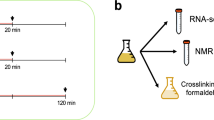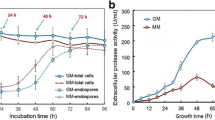Abstract
In this study global changes in gene expression were monitored in Bacillus subtilis cells entering stationary growth phase owing to starvation for glucose. Gene expression was analysed in growing and starving cells at different time points by full-genome mRNA profiling using DNA macroarrays. During the transition to stationary phase we observed extensive reprogramming of gene expression, with ~1000 genes being strongly repressed and ~900 strongly up-regulated in a time-dependent manner. The genes involved in the response to glucose starvation can be assigned to two main classes: (i) general stress/starvation genes which respond to various stress or starvation stimuli, and (ii) genes that respond specifically to starvation for glucose. The first class includes members of the σB-dependent general stress regulon, as well as 90 vegetative genes, which are strongly down regulated in the course of the stringent response. Among the genes in the second class, we observed a decrease in the expression of genes encoding proteins required for glucose uptake, glycolysis and the tricarboxylic acid cycle. Conversely, many carbohydrate utilisation systems that depend on phosphotransferase systems (PTS) or ABC transporters were activated. The expression of genes required for utilisation or generation of acetate indicates that acetate constitutes an important energy source for B. subtilis during periods of glucose starvation. Finally, genome wide mRNA profiling data can be used to predict new metabolic pathways in B. subtilis. Thus, our data suggest that glucose-starved cells are able to degrade branched-chain fatty acids to pyruvate and succinate via propionyl-CoA using the methylcitrate pathway. This pathway appears to link lipid degradation to gluconeogenesis in glucose-starved cells.









Similar content being viewed by others
References
Ali NO, Bignon J, Rapoport G, Debarbouille M (2001) Regulation of the acetoin catabolic pathway is controlled by sigma L in Bacillus subtilis. J Bacteriol 183:2497–2504
Anagnostopoulos C, Spizizen J (1961) Requirements for transformation in Bacillus subtilis. J Bacteriol 81:7471–7476
Bandow JE, Brötz H, Hecker M (2002) Bacillus subtilis tolerance of moderate concentrations of rifampin involves the sigma(B)-dependent general and multiple stress response. J Bacteriol 184:459–467
Bernhardt J, Weibezahn J, Scharf C, Hecker M (2003) A movie of the life of Bacillus subtilis during feast and famine: visualisation of protein synthesis during glucose starvation by proteome analysis. Genome Res 13:224–237
Blencke HM, Homuth G, Ludwig H, Mäder U, Hecker M, Stülke J (2003) Transcriptional profiling of gene expression in response to glucose in Bacillus subtilis: regulation of the central metabolic pathways. Metab Eng 5:133–149
Bryan EM, Beall BW, Moran CP Jr (1996) A sigma E dependent operon subject to catabolite repression during sporulation in Bacillus subtilis. J Bacteriol 178:4778–4786
Cashel M, Gentry DR, Hernandez VJ, Vinella D (1996) The stringent response. In: Neidhardt FC, Curtiss III R, Ingraham JL, Lin ECC, Low KB, Magasanik B, Reznikoff WS, Riley M, Schaechter M, Umbarger HE (eds) Escherichia coli and Salmonella: cellular and molecular biology, 2nd edn. ASM Press, Washington DC, pp1458–1496
Conway T, Schoolnik GK (2003) Microarray expression profiling: capturing a genome-wide portrait of the transcriptome. Mol Microbiol 47:879–889
Dauner M, Storni T, Sauer U (2001) Bacillus subtilis metabolism and energetics in carbon-limited and excess-carbon chemostat culture. J Bacteriol 183:7308–7317
Deutscher J, Galinier A, Martin-Verstraete I. (2002) Carbohydrate uptake and metabolism. In: Sonenshein AL, Hoch JA, Losick R (eds) Bacillus subtilis and its closest relatives: from genes to cells. ASM Press, Washington DC, pp 129–150
Drzewiecki K, Eymann C, Mittenhuber G, Hecker M (1998) The yvyD gene of Bacillus subtilis is under dual control of sigmaB and sigmaH. J Bacteriol 180:6674–6680
Eymann C, Homuth G, Scharf C, Hecker M (2002) Bacillus subtilis functional genomics: global characterization of the stringent response by proteome and transcriptome analysis. J Bacteriol 184:2500–2520
Gerth U, Krüger E, Derre I, Msadek T, Hecker M (1998) Stress induction of the Bacillus subtilis clpP gene encoding a homologue of the proteolytic component of the Clp protease and the involvement of ClpP and ClpX in stress tolerance. Mol Microbiol 28:787–802
Gropp M, Eizenman E, Glaser G, Samarrai W, Rudner R (1994) A relA(S) suppressor mutant allele of Bacillus subtilis which maps to relA and responds only to carbon limitation. Gene 140:91–96
Hecker M, Völker U (2001) General stress response of Bacillus subtilis and other bacteria. Adv Microb Physiol 44:35–91
Homuth G, Masuda S, Mogk A, Kobayashi Y, Schumann W (1997) The dnaK operon of Bacillus subtilis is heptacistronic. J Bacteriol 179:1153–1164
Horswill AR, Escalante-Semerena JC (1997) Propionate catabolism in Salmonella typhimurium LT2: two divergently transcribed units comprise the prp locus at 8.5 centisomes, prpR encodes a member of the sigma-54 family of activators, and the prpBCDE genes constitute an operon. J Bacteriol 179:928–940
Huynen MA, Dandekar T, Bork P (1999) Variation and evolution of the citric-acid cycle: a genomic perspective. Trends Microbiol 7:281–291
Inaoka T, Matsumura Y, Tsuchido T (1998) Molecular cloning and nucleotide sequence of the superoxide dismutase gene and characterization of its product from Bacillus subtilis . J Bacteriol 180:3697–3703
Kaneda T (1977) Fatty acids of the genus Bacillus: an example of branched-chain preference. Bacteriol Rev 41:391–418
Kaneda T (1991) Iso-fatty and anteiso-fatty acids in bacteria: biosynthesis, function, and taxonomic significance. Microbiol Rev 55:288–302
Kanehisa M, Goto S, Kawashima S, Nakaya A (2002) The KEGG databases at GenomeNet. Nucleic Acids Res 30:42–46
Kim KS, Farrand SK (1996) Ti plasmid-encoded genes responsible for catabolism of the crown gall opine mannopine by Agrobacterium tumefaciens are homologs of the T-region genes responsible for synthesis of this opine by the plant tumor. J Bacteriol 178:3275–3284
Kim HJ, Jourlin-Castelli C, Kim SI, Sonenshein AL (2002) Regulation of the Bacillus subtilis ccpC gene by ccpA and ccpC. Mol Microbiol 43:399–410
Kunst F et al (1997) The complete genome sequence of the gram-positive bacterium Bacillus subtilis. Nature 390:249–256
Ludwig H, Homuth G, Schmalisch M, Dyka FM, Hecker M, Stülke J (2001) Transcription of glycolytic genes and operons in Bacillus subtilis: evidence for the presence of multiple levels of control of the gapA operon. Mol Microbiol 41:409–422
Matsunaga I, Ueda A, Fujiwara N, Sumimoto T, Ichihara K (1999) Characterization of the ybdT gene product of Bacillus subtilis: novel fatty acid beta-hydroxylating cytochrome P450. Lipids 34:841–846
Mittenhuber G (2001) Comparative genomics and evolution of genes encoding bacterial (p)ppGpp synthetases/hydrolases (the Rel, RelA and SpoT proteins). J Mol Microbiol Biotechnol 3:585–600
Molle V, Nakaura Y, Shivers RP, Yamaguchi H, Losick R, Fujita Y, Sonenshein AL (2003) Additional targets of the Bacillus subtilis global regulator CodY identified by chromatin immunoprecipitation and genome-wide transcript analysis. J Bacteriol 185:1911–1922
Moszer I, Jones LM, Moreira S, Fabry C, Danchin A (2002) SubtiList: the reference database for the Bacillus subtilis genome. Nucleic Acids Res 30:62–65
Msadek T (1999) When the going gets tough: survival strategies and environmental signaling networks in Bacillus subtilis. Trends Microbiol 7:201–207
Nishino T, Gallant J, Shalit P, Palmer L, Wehr T (1979) Regulatory nucleotides involved in the Rel function of Bacillus subtilis. J Bacteriol 140:671–679
O’Reilly M, Devine KM (1997) Expression of AbrB, a transition state regulator from Bacillus subtilis, is growth phase dependent in a manner resembling that of Fis, the nucleoid binding protein from Escherichia coli. J Bacteriol 179:522–529
Petersohn A (2003) Funktion SigB-abhängiger Stressproteine in Bacillus subtilis. PhD Thesis. Ernst-Moritz-Arndt-Universität, Greifswald
Petersohn A, Engelmann S, Setlow P, Hecker M (1999) The katX gene of Bacillus subtilis is under dual control of sigmaB and sigmaF. Mol Gen Genet 262:173–179
Petersohn A, Brigulla M, Haas S, Hoheisel JD, Völker U, Hecker M (2001) Global analysis of the general stress response of Bacillus subtilis. J Bacteriol 183:5617–5631
Piggot PJ, Losick R (2002) Sporulation genes and intercompartmental regulation. In: Sonenshein AL, Hoch JA, Losick R (eds) Bacillus subtilis and its closest relatives: from genes to cells. ASM Press, Washington DC, pp 483–517
Price CW, Fawcett P, Ceremonie H, Su N, Murphy CK, Youngman P (2001) Genome-wide analysis of the general stress response in Bacillus subtilis. Mol Microbiol 41:757–774
Reizer J, Bachem S, Reizer A, Arnaud M, Saier MH Jr., Stülke J (1999) Novel phosphotransferase system genes revealed by genome analysis—the complete complement of PTS proteins encoded within the genome of Bacillus subtilis. Microbiology 145:3419–3429
Rosenkrantz MS, Dingman DW, Sonenshein AL (1985) Bacillus subtilis citB gene is regulated synergistically by glucose and glutamine. J Bacteriol 164:55–64
Servant P, Le Coq D, Aymerich S (2004) CcpN (YqzB), a novel regulator for CcpA-independent catabolite repression of Bacillus subtilis gluconeogenic genes. Mol Microbiol, in press
Sonenshein AL (2000) Bacterial sporulation: a response to environmental signals. In: Storz G, Hengge-Aronis R (eds) Bacterial stress responses. ASM Press, Washington DC, pp 199–221
Sonenshein AL (2002) The Krebs citric acid cycle. In: Sonenshein AL, Hoch JS, Losick R (eds) Bacillus subtilis and its closest relatives: from genes to cells. ASM Press, Washington DC, pp 151–162
Stragier P, Losick R (1996) Molecular genetics of sporulation in Bacillus subtilis. Annu Rev Genet 30:297–241
Stülke J, Hillen W (2000) Regulation of carbon catabolism in Bacillus species. Annu Rev Microbiol 54:849–880
Stülke J, Hanschke R, Hecker M (1993) Temporal activation of beta-glucanase synthesis in Bacillus subtilis is mediated by the GTP pool. J Gen Microbiol 139:2041–2045
Tobisch S, Glaser P, Kruger S, Hecker M (1997) Identification and characterization of a new beta-glucoside utilization system in Bacillus subtilis. J Bacteriol 179:496–506
Tobisch S, Zühlke D, Bernhardt J, Stülke J, Hecker M (1999) Role of CcpA in regulation of the central pathways of carbon catabolism in Bacillus subtilis. J Bacteriol 181:6996–7004
Wendrich TM, Marahiel MA (1997) Cloning and characterization of a relA/spoT homologue from Bacillus subtilis. Mol Microbiol 26:65–79
Yoshida K, Kobayashi K, Miwa Y, Kang CM, Matsunaga M, Yamaguchi H, Tojo S, Yamamoto M, Nishi R, Ogasawara N, Nakayama T, Fujita Y (2001) Combined transcriptome and proteome analysis as a powerful approach to study genes under glucose repression in Bacillus subtilis. Nucleic Acids Res 29:683–692
Zhang B, Struffi P, Kroos L (1999) Sigma K can negatively regulate sigE expression by two different mechanisms during sporulation of Bacillus subtilis. J Bacteriol 181:4081–4088
Acknowledgements
J. Weibezahn and T. Koburger contributed equally to this work. This work was supported by grants from the BMBF (No. 031U107A), the DFG (No. HE1887/7-1) and the “Fonds der Chemischen Industrie” to M.H. We thank Colin Harwood and Jörg Stülke for critically reading the manuscript, and Stéphane Aymerich for providing data before publication. The work was carried out in compliance with the laws governing genetic experimentation in Germany
Author information
Authors and Affiliations
Corresponding author
Additional information
Communicated by A. Kondorosi
Rights and permissions
About this article
Cite this article
Koburger, T., Weibezahn, J., Bernhardt, J. et al. Genome-wide mRNA profiling in glucose starved Bacillus subtilis cells. Mol Genet Genomics 274, 1–12 (2005). https://doi.org/10.1007/s00438-005-1119-8
Received:
Accepted:
Published:
Issue Date:
DOI: https://doi.org/10.1007/s00438-005-1119-8




